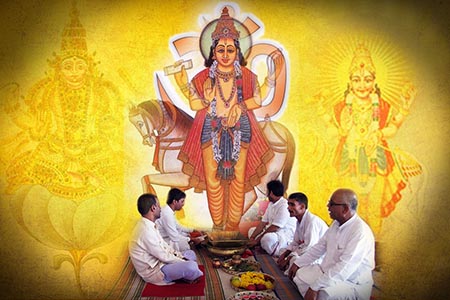 NAVRATRI PUJA
NAVRATRI PUJA
About Puja
Navratri Puja is performed to invoke nine manifestations of Maa Durga. The word Navratri breaks down to Nav(Nine); and Ratri(Nights); which signifies the nine day celebration to honour the Nine Swaroops of Shakti that breathed life into this world. There are in-all four different Navratris celebrated throughout the year.
Significance of Navratri Puja:
Navratri Puja is performed to revere Goddess Durga who is considered to be Maa AdhyaShakti – The Universal Mother. Each day of Navratri is dedicated to each of the nine Avatars of Shakti with rituals that invoke her powers and appeals her to bestow her blessing and kindness on us. The first incarnation of Shakti is Shailputri who is worshipped on the first day.This is then followed by invoking of Brahmacharini, Chandreghata, Kushmanda, Skandmata, Katyayani, Kaalratri, Mahagauri and Siddhidatri on subsequent days that continues till the ninth day. One can find the mention of Navratri and praises of devotional saadhana of Shakti, known as Devi-sukta, Usha-sukta and Ratri-sukta, in the age-old texts of Rig Veda. Chaitra Navratri is observed on the first day of Ashwani during the bright fortnight, which also falls around the beginning of solar influence and warmer climate.
Navratri is the celebration of Maa Durga – the epitome of Shakti, in her various manifestations along with their varied powers.
Hence performing Navratri Puja is said to benefit in numerous ways like -
• Showers happiness, wealth and prosperity on the devotees.
• Fulfills wishes and desires.
• Bestows knowledge and spiritual enlightenment.
• Protects oneself and the household from evil and negative energies.
• Alleviates distress from life’s ongoing trials.
Occasions to Perform Navratri Puja:
Navratri falls around four different times in a year, which is celebrated with religious fervor across different parts of India. They include
1)Magh Navratri – It is mainly observed in certain parts of Northern India and falls between January and February.
2)Vasant Navratri – It falls between March and April and is also famously known as Ram Navratri or Chaitra Navratri.
3)Ashaadi Navratri – Observed by only certain regions in Northern India in the month of June or July.
4)Shardiya Navratri – Known as Maha Navratri. Celebrated across all parts of India, especially Western regions, either in late September or early October.
While the Magh and Ashaadi Navratri is known as Gupt Navratri celebrated by Saadhaks; the Chaitra Navratri and Shardiya or Maha Navratri is considered to be of utmost importance and celebrated with great zeal all across India.
Navratri Puja Vidhi:
Navratri celebrations include both – the Puja and Yagna rituals along with celebratory dance – Garba with devotional songs. Some people especially Gujaratis and people in western India, bring and setup Maa no Garbo, which represent welcoming Maa AdhyaShakti into their own house
The Puja vidhi begins with Ghatastapana which represents the invocation of Maa AdhyaShakti, done on the first day of the Navratri as per muhurat.
• A low table is covered with red cloth and placed at the most auspicious direction in the house, preferably near Puja Ghar.
• Maa Durga or Jagdamba’s photo or idol is place on the right on the table.
• A kalash filled with water is placed on the left. Five mango leaves and a coconut are placed over the kalash. The Kalash is placed over either wheat or rice grains on the table.
Sacred Moli is tied around Kalash and a swastika is drawn in the front.
• A clay pot is filled with water and a few barley seeds are added to it as symbolic gesture of life-creation that Maa Adhyashakti represents.
• The clay pot is also kept near the table.
• A Tilak is applied to Maa Adhyashakti’s idol along with both the pots.
• Akshatas – Rice grains are offered.
• Garlands and Naivedya is offered to the Goddess.
• A Ghee diya is lit along with burning a dhoop and incense and an Aarti is performed.
• The Puja rituals are carried out each day for the following nine days.
• Many women perform Kanya Puja on the ninth day. This involves performing Puja of little girls who haven’t reached the age of puberty and feeding them the Special Bhog prepared on the day.
